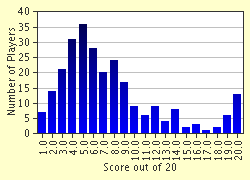Quiz Answer Key and Fun Facts
1. Macha, daughter of Sainrith mac Imbaith, cursed the men of Ulster for nine generations. Why did she so curse the Ulstermen?
2. Several accounts are given of the birth of Setanta, who later came to be known by a more famous name. His mother was Deichtine, sister of Conchobar, King of Ulster. Some later accounts assign his paternity to Conchobar himself (implying a system of matrilineal descent in prehistoric {Ireland?);} others to a petty chieftain of Ulster, Deichtine's husband Sualtaim. But in most accounts Setanta's father is a god. Which god is said to have been Setanta's true father?
3. Setanta was six years old when he received the name Cuchulainn. What did his new name mean?
4. Before she would marry the pre-pubescent Cuchulainn, Emer, daughter of Forgall imposed certain conditions. Which of the following was NOT a feat Cuchulainn would be required to perform before Emer would consent?
5. Forgall wasn't sure he wanted young Cuchulainn as a son-in-law, so he persuaded Conchobar to send the lad out for dangerous combat training, which Forgall hoped would lead to his death. One of Cuchulainn's teachers was the shadowy warrior-woman Scathac, with whose daughter (Uathac) Cuchulainn lost his virginity. Which of the following is NOT a feat Scathac taught Cuchulainn to perform?
6. Who was the mother of Cuchulainn's first son?
7. At a feast hosted by Bricriu Mac Carbad (of the venomous tongue), Cuchulainn is declared the Champion of Ulster. What does he do to be so honored?
8. Who brought about the fall of the Red Branch of Ulster?
9. The centerpiece of the Ulster Cycle is the Tain Bo Cuailgne, the Cattle-Raid of Cooley, sometimes called 'The Irish Iliad.' The questions posed so far have covered the events that serve as prefatory material to the Tain (or are related in 'flashbacks' therein). We now turn to the bare beginnings of the central episode. The Cattle-Raid takes place because of the existence of an incredibly valuable bull in Cooley, matched only by an equally valuable bull in Connaught. Which of the following is the (partial) explanation for the existence and location of the two fabulous bulls?
10. The Cattle-Raid of Cooley, as its name implies, is all about an effort to steal the fabulous bull Dub (from its Ulsterman owner, Daire mac Fiachna). Which of the following is the (partial) explanation of why someone wanted to steal the bull?
11. How did it happen that the Connaught war host entered Ulster unopposed, without provoking outcry? Why wasn't Cuchulainn there to guard the marches?
12. On Conaille Plain Cuchulainn killed three hundred warriors of Connaught with his sling, over the course of three nights. Medb negotiated with him to put a stop to that, and they agreed that the forces of Connaught would send a single champion to do combat against Cuchulainn at the 'ford of battle' each day, and that the Connaught host would only march during the pendency of each combat. In exchange, Cuchulainn would set aside his staff-sling. How many days did it take Cuchulainn to slay Nathcrantail, the spear-throwing first champion of Connaught?
13. Cuchulainn was important to the Ulstermen because he alone among them was immune to the Curse of Macha (perhaps due to his divine parentage), which left them weak and helpless in their times of greatest need. However, after a desperate battle at the ford, in which the Morrigan's intervention left Cuchulainn sorely wounded, Cuchulainn's divine father healed him be sending him into a three-day sleep. What martial asset did the forces of Ulster call upon to defend them while Cuchulainn slept?
14. Medb sent many champions to slay Cuchulainn at the ford, and none succeeded. Which of the following gave Cuchulainn far and away his hardest fight at the ford of battle?
15. While Cuchulainn recuperated from wounds inflicted in the flight alluded to in the preceding question, his mortal (or foster) father Sualtaim met his end. How did Sualtaim die?
16. What was the outcome of the final battle between the forces of Ulster and the forces of Connaught at the Plain of Garech?
17. What was the ultimate fate of the two fabulous bulls (Dub of Cuailgne and Finnbennach of Connaught) after all the dust had settled?
18. Cuchulainn had other adventures as well, after winning undying glory for defending Ulster single-handed against the marauders of Connaught. In one episode, the hero spends a month in the Irish 'otherworld,' Tir na Nog. Which of the following is the (partial) explanation for Cuchulainn's journey into that fey realm?
19. Which of the following did NOT figure in the death of Cuchulainn?
20. A final question to prove that the Ulster Cycle isn't ALL about {Cuchulainn;} what body part was used to kill King Conchobar?
Source: Author
xaosdog
This quiz was reviewed by FunTrivia editor
looney_tunes before going online.
Any errors found in FunTrivia content are routinely corrected through our feedback system.

